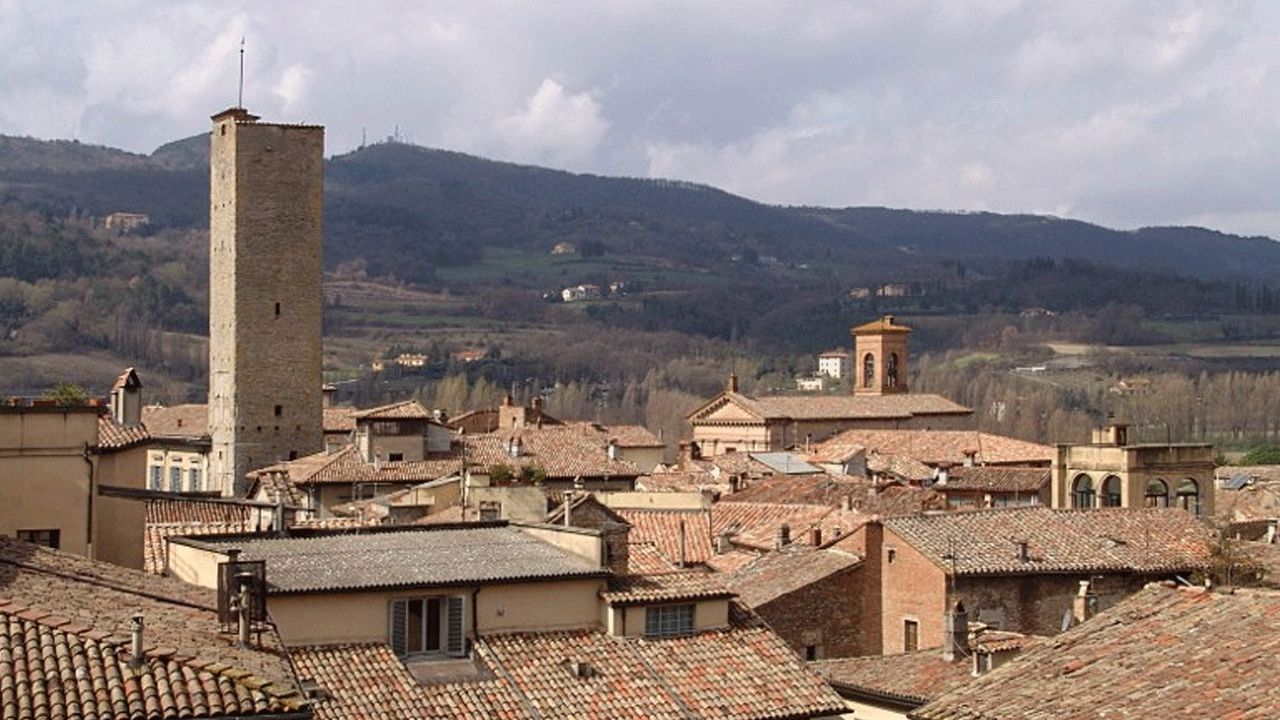
“…immense amphitheatre which nature alone can create..” this was what Pliny the Younger wrote about Città di Castello.
Città di Castello is located among the rolling hills in the lands bordering with Tuscany, known as “alta Valtiberina” and is built on the left bank of the Tiber river. Ancient Umbrian town not submitted by the Etruscans, it was a thriving Roman municipality, named Tifernum Tiberinum, recalled by Pliny the Younger in his epistles.
During the second half of the XVth century, the noble Vitelli family took control over the city. They were particularly attentive to the fine arts and culture in general and brought together artists such as: Luca Signorelli, Raffaello Sanzio, Angelo da Orvieto, Antonio da Sangallo the Younger, Giorgio Vasari and many others.
Città di Castello has preserved its powerful sixteenth century city walls. The Cathedral of the “Santissimi Florido e Amanzio” of the XIth century has a large staircase; the unfinished baroque façade of the XVIIth century, is adorned with columns, pilasters and niches; at his side a round Campanile of the thirteenth century, Ravenna style. Inside, we can see many important artworks: a painting of the sixteenth century by Rosso Fiorentino, frescoes by Tommaso Conca, a painting by Pomarancio, and the crypt, where the relics of Saints Florido and Amanzio and other saints are kept. In the Cathedral there is also the Museum of the Duomo which houses a “Madonna” by Pinturicchio; a decorative coating of the altar front (Paliotto) made in silver with golden “repoussages” of the XIIth century, a pastoral of the fourteenth century, attributed to Goro di Gregorio, and many other early Christian liturgical objects of the Vth and VIth centuries. Another interesting site in Città di Castello is the impressive “Palazzo Vitelli alla Cannoniera”, built between 1521 and 1532, today seat of the Town Art Gallery of Città di Castello, second in importance, only to the National Gallery of Umbria. Here you can admire many masterpieces of great masters: Raffaello, Luca Signorelli, Giovanni and Andrea della Robbia, Raffaellino del Colle, Pomarancio, Domenico Ghirlandaio and so on.
In Città di Castello there are other important churches to visit: the church of San Domenico, of the fourteenth century, in pure gothic style; the adjacent former convent in which the cloister with frescoed lunettes is to be admired; the church of Santa Maria Maggiore, dated back by the end of the fifteenth century, which houses frescoes of the XVth-XVIth centuries and a wooden chorus of the XVIth century.
Also worth visiting is the Palazzo Albizzini, seat of the First Burri Museum. Alberto Burri, born in Città di Castello, whose artworks draw inspiration from his homeland, is one of the most important artists of our time. For those who a admire this artist, Città di Castello proposes its museums: the Collection at Palazzo Albizzini that consists of about 130 works from 1948 to 1989, and the exhibition hall of the “Ex Seccatoi del Tabacco”, which houses 128 works from 1970 to 1993.
A succession of festivals, expositions, celebrations, music, sounds and colours fulfilling the squares and the alleys of the city: just knowing how to choose, there is a lot to suit every taste and need.
First of all the “Festival delle Nazioni”, the music show that has reached international prestige; the “Mostra del Libro antico e della stampa antica”, show of ancient books and printings, in a city that is a pole of excellence in graphics; the “Mostra Nationale del Cavallo”, one of the most important horse shows in our country.
Atmospheres and sensations of the past can be felt also in folklore and re-enactments, such as the “Giornate dell’Artigianato Storico”, the “Palio dell’Oca”, the challenges of the “Balestrieri” ; in religious initiatives, such as the “Secolare Processione del Venerdi Santo” and the “Donazione della Cera”, on the occasion of the Patron Saint. Do not forget the markets, the fairs, the monthly market of “Retrò”, in the heart of the old downtown. Our culinary excellences also become protagonists in festivals and celebrations that are related to popular and peasant traditions, where the king of cuisine is Its Majesty the truffle, to which many festivals throughout all the territory of the Alto Tevere are dedicated. A famous event in Città di Castello, is the “Mostra Mercato del Tartufo Bianco”, which takes place in the streets and squares of the old downtown on the first weekend of November. Initiatives for all tastes and needs where, together with the traditional ones, the different expressions of contemporary creativity come up beside.
During the second half of the XVth century, the noble Vitelli family took control over the city. They were particularly attentive to the fine arts and culture in general and brought together artists such as: Luca Signorelli, Raffaello Sanzio, Angelo da Orvieto, Antonio da Sangallo the Younger, Giorgio Vasari and many others.
Città di Castello has preserved its powerful sixteenth century city walls. The Cathedral of the “Santissimi Florido e Amanzio” of the XIth century has a large staircase; the unfinished baroque façade of the XVIIth century, is adorned with columns, pilasters and niches; at his side a round Campanile of the thirteenth century, Ravenna style. Inside, we can see many important artworks: a painting of the sixteenth century by Rosso Fiorentino, frescoes by Tommaso Conca, a painting by Pomarancio, and the crypt, where the relics of Saints Florido and Amanzio and other saints are kept. In the Cathedral there is also the Museum of the Duomo which houses a “Madonna” by Pinturicchio; a decorative coating of the altar front (Paliotto) made in silver with golden “repoussages” of the XIIth century, a pastoral of the fourteenth century, attributed to Goro di Gregorio, and many other early Christian liturgical objects of the Vth and VIth centuries. Another interesting site in Città di Castello is the impressive “Palazzo Vitelli alla Cannoniera”, built between 1521 and 1532, today seat of the Town Art Gallery of Città di Castello, second in importance, only to the National Gallery of Umbria. Here you can admire many masterpieces of great masters: Raffaello, Luca Signorelli, Giovanni and Andrea della Robbia, Raffaellino del Colle, Pomarancio, Domenico Ghirlandaio and so on.
In Città di Castello there are other important churches to visit: the church of San Domenico, of the fourteenth century, in pure gothic style; the adjacent former convent in which the cloister with frescoed lunettes is to be admired; the church of Santa Maria Maggiore, dated back by the end of the fifteenth century, which houses frescoes of the XVth-XVIth centuries and a wooden chorus of the XVIth century.
Also worth visiting is the Palazzo Albizzini, seat of the First Burri Museum. Alberto Burri, born in Città di Castello, whose artworks draw inspiration from his homeland, is one of the most important artists of our time. For those who a admire this artist, Città di Castello proposes its museums: the Collection at Palazzo Albizzini that consists of about 130 works from 1948 to 1989, and the exhibition hall of the “Ex Seccatoi del Tabacco”, which houses 128 works from 1970 to 1993.
A succession of festivals, expositions, celebrations, music, sounds and colours fulfilling the squares and the alleys of the city: just knowing how to choose, there is a lot to suit every taste and need.
First of all the “Festival delle Nazioni”, the music show that has reached international prestige; the “Mostra del Libro antico e della stampa antica”, show of ancient books and printings, in a city that is a pole of excellence in graphics; the “Mostra Nationale del Cavallo”, one of the most important horse shows in our country.
Atmospheres and sensations of the past can be felt also in folklore and re-enactments, such as the “Giornate dell’Artigianato Storico”, the “Palio dell’Oca”, the challenges of the “Balestrieri” ; in religious initiatives, such as the “Secolare Processione del Venerdi Santo” and the “Donazione della Cera”, on the occasion of the Patron Saint. Do not forget the markets, the fairs, the monthly market of “Retrò”, in the heart of the old downtown. Our culinary excellences also become protagonists in festivals and celebrations that are related to popular and peasant traditions, where the king of cuisine is Its Majesty the truffle, to which many festivals throughout all the territory of the Alto Tevere are dedicated. A famous event in Città di Castello, is the “Mostra Mercato del Tartufo Bianco”, which takes place in the streets and squares of the old downtown on the first weekend of November. Initiatives for all tastes and needs where, together with the traditional ones, the different expressions of contemporary creativity come up beside.

 Italiano
Italiano Deutsch
Deutsch









